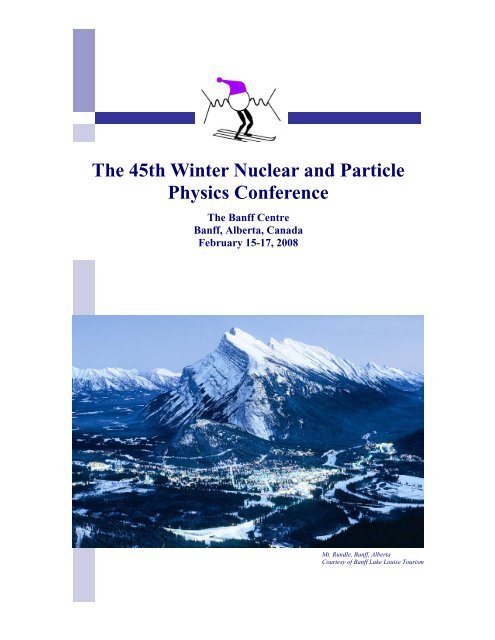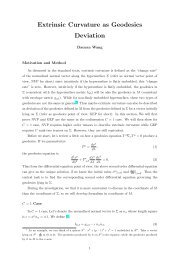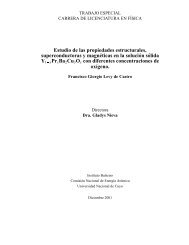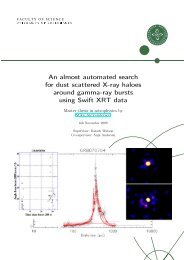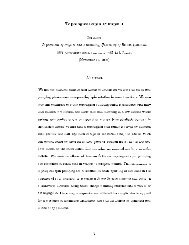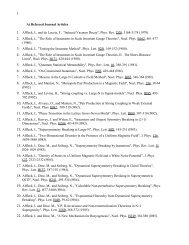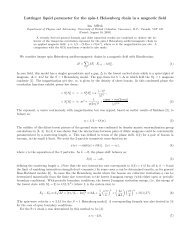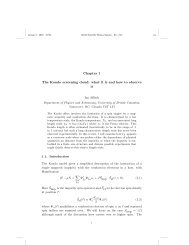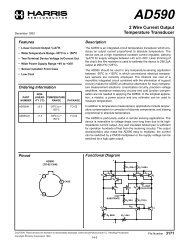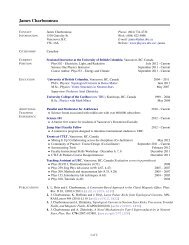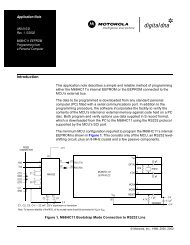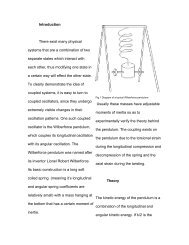Here - UBC Physics & Astronomy - University of British Columbia
Here - UBC Physics & Astronomy - University of British Columbia
Here - UBC Physics & Astronomy - University of British Columbia
Create successful ePaper yourself
Turn your PDF publications into a flip-book with our unique Google optimized e-Paper software.
The 45th Winter Nuclear and Particle<br />
<strong>Physics</strong> Conference<br />
The Banff Centre<br />
Banff, Alberta, Canada<br />
February 15-17, 2008<br />
Mt. Rundle, Banff, Alberta<br />
Courtesy <strong>of</strong> Banff Lake Louise Tourism
The 45th Winter Nuclear and<br />
Particle <strong>Physics</strong> Conference<br />
The Banff Centre<br />
Banff, Alberta, Canada<br />
February 15-17, 2008<br />
Welcome to WNPPC 2008!<br />
We are pleased to welcome you to WNPPC 08. The next few days will be full <strong>of</strong> information, with some<br />
time to enjoy the beautiful mountain surroundings along the way. <strong>Here</strong> are a few notes to start your<br />
weekend <strong>of</strong>f right.<br />
Wireless Internet:<br />
Free Wireless Internet is available throughout the Banff Centre in several buildings. To take advantage <strong>of</strong><br />
this service, you must have wireless capability on your laptop that is preconfigured for DHCP. The<br />
wireless network is titled “Banffcentre” and should appear in your list <strong>of</strong> available networks.<br />
Bagged Lunch:<br />
A bagged lunch will be provided for those who requested it in advance. These will be available in the<br />
TCPL Foyer.<br />
Building Names and Abbreviations:<br />
TCPL = TransCanada Pipelines Pavilion Building<br />
‣ Meeting Room PAV 201<br />
PDC = Pr<strong>of</strong>essional Development Centre<br />
‣ Front Desk and Bedrooms<br />
SBB = Sally Borden Building<br />
‣ Vistas Dining Room, 4 th Floor<br />
‣ Recreational Facilities<br />
Fitness and Recreation:<br />
The Banff Centre’s Sally Borden Recreation Facility is available to all overnight guests <strong>of</strong> the Banff Centre<br />
at no extra charge. The facility includes a 25 metre pool, steam rooms, whirlpool, weight room, full-sized<br />
gymnasium with indoor running track, badminton, squash court, and climbing wall.
Skiing:<br />
For those looking to take advantage <strong>of</strong> the local mountains on Saturday afternoon, there are two ski hills<br />
near Banff.<br />
Ski Banff @ Norquay<br />
Sunshine Village<br />
www.banffnorquay.com<br />
www.skibanff.com<br />
Tourism Information:<br />
For more information on Banff, visit www.banfflakelouise.com.<br />
The organizing committee would like to express our sincere gratitude to all invited speakers for<br />
accepting our invitation and attending at their own expense. We also welcome all <strong>of</strong> the researchers<br />
with contributed papers.<br />
Our thanks go to TRIUMF and the <strong>UBC</strong> Department <strong>of</strong> <strong>Physics</strong> and <strong>Astronomy</strong> for their financial support,<br />
particularly in sponsoring three prizes for the best student presentations. The winners will be<br />
announced at the end <strong>of</strong> the last session on Sunday.<br />
We also would like to express many thanks to the previous organizing committees for their advice and<br />
support.<br />
We welcome all comments, and hope you enjoy the conference. For more information please talk to the<br />
organizers or see the conference website at http://www.phas.ubc.ca/wnppc08.<br />
Joanna Karczmarek, WNPPC08 Co-Chair<br />
Department <strong>of</strong> <strong>Physics</strong> and <strong>Astronomy</strong>, <strong>University</strong> <strong>of</strong> <strong>British</strong> <strong>Columbia</strong><br />
karczmarek@physics.ubc.ca<br />
Colin Gay, WNPPC08 Co-Chair<br />
Department <strong>of</strong> <strong>Physics</strong> and <strong>Astronomy</strong>, <strong>University</strong> <strong>of</strong> <strong>British</strong> <strong>Columbia</strong><br />
cgay@physics.ubc.ca<br />
Sandi Miller, WNPPC08 Secretary<br />
TRIUMF<br />
sandim@triumf.ca
The 45th Winter Nuclear and<br />
Particle <strong>Physics</strong> Conference<br />
The Banff Centre<br />
Banff, Alberta, Canada<br />
February 15-17, 2008<br />
SCHEDULE<br />
Friday, February 15, 2008<br />
4:00 – 6:00pm Registration PDC Foyer<br />
5:30 – 7:00pm Dinner Dining Room<br />
6:30 – 8:00pm Registration TCPL Foyer<br />
7:30 – 9:00pm Plenary Session TCPL Room 201<br />
9:00 – 11:00pm Reception TCPL Foyer<br />
Saturday, February 16, 2008<br />
7:00 – 8:30am Breakfast Dining Room<br />
8:30 – 10:15am Plenary Session TCPL Room 201<br />
10:15 – 10:30am C<strong>of</strong>fee Break TCPL Foyer<br />
10:30 – 12:15pm Plenary Session TCPL Room 201<br />
12:15pm Lunch Dining Room<br />
**Free Afternoon**<br />
6:00 – 7:30pm Dinner Dining Room<br />
7:30 – 9:00pm Plenary Session TCPL Room 201<br />
9:00 – 9:15pm C<strong>of</strong>fee Break TCPL Foyer<br />
9:15 – 10:45pm Plenary Session TCPL Room 201<br />
Sunday, February 17, 2008<br />
7:00 – 8:30am Breakfast Dining Room<br />
8:30 – 10:15am Plenary Session TCPL Room 201<br />
10:15 – 10:30am C<strong>of</strong>fee Break TCPL Foyer<br />
10:30 – 12:15pm Plenary Session TCPL Room 201<br />
12:15pm Lunch Dining Room
WNPPC08 Schedule <strong>of</strong> Talks<br />
Friday Feb 15<br />
Session 1<br />
Time<br />
Speaker<br />
19:30 - 19:35 Greetings<br />
19:35 - 20:10 B. Davids<br />
Recent Experiments in Nuclear Astrophysics at TRIUMF<br />
20:10 - 20:30 R. MacDonald<br />
Results <strong>of</strong> a New Muon Decay Measurement by TWIST<br />
20:30 - 20:50 J. Bueno<br />
Progress on the final measurements from the TWIST experiment<br />
20:50 - 21:10 S. Triambak<br />
Isospin symmetry breaking in the mass-32 system and the Standard Model<br />
21:10 - 23:00 Reception<br />
Saturday Feb 16<br />
Session 2<br />
Time<br />
Speaker<br />
8:30 - 9:05 P. Krieger<br />
The ATLAS Detector at the CERN Large Hadron Collider<br />
9:05 - 9:25 G. McGregor<br />
Counting B mesons at BaBar<br />
9:25 - 9:45 G. Kertzscher<br />
Search for Charged Higgs Boson Using the DZero Experiment<br />
9:45 - 9:50 DNP Thesis Prize presentation<br />
9:50 - 10:10 S. Turbide<br />
Electromagnetic radiation from matter under extreme conditions<br />
10:10 - 10:30 C<strong>of</strong>fee
Session 3<br />
Time<br />
cancelled(*)<br />
Speaker<br />
A. Chen<br />
Experiments with radioactive ion beams and the origin <strong>of</strong> galactic Aluminum-26<br />
10:30 - 10:50 K.G. Leach<br />
Internal Decay and the Superallowed Branching Ratio for the Emitter<br />
10:50 - 11:10 A.A. Phillips<br />
Structure <strong>of</strong> the States in<br />
11:10 - 11:30 P. Finlay<br />
Precision Branching Ratio Measurement for the Superallowed<br />
11:30 - 11:50 C. Sumithrarachchi<br />
Study <strong>of</strong> Beta-delayed neutron decay <strong>of</strong><br />
(*) This talk is cancelled due to an emergency in the speaker’s family<br />
Emitter<br />
Free Afternoon<br />
Session 4<br />
Time<br />
Speaker<br />
19:30 - 20:05 A. Ritz<br />
Direct and indirect detection <strong>of</strong> pseudo-degenerate WIMP dark matter<br />
20:05 - 20:25 M. Forbes<br />
Observing Dark Matter: A ``Strange'' Proposal<br />
20:25 - 20:45 K. Lawson<br />
Observational signatures <strong>of</strong> dark matter?<br />
20:45 - 21:05 K. Wunderle<br />
Can pr<strong>of</strong>iles from N-body simulations explain structures down to globular cluster<br />
scales?<br />
21:05 - 21:25 C<strong>of</strong>fee<br />
Session 5<br />
Time<br />
Speaker<br />
21:25 - 22:00 D. Lunney<br />
Weighing atoms for (nuclear) physics<br />
22:00 - 22:20 E. O'Connor<br />
Light elements in Supernovae<br />
22:20 - 22:40 U. Hager<br />
Nuclear astrophysics with DRAGON
Sunday Feb 17<br />
Session 6<br />
Time<br />
Speaker<br />
8:30 - 9:05 H. Tanaka<br />
The T2K Experiment: The Next Generation <strong>of</strong> Neutrino Oscillation Studies<br />
9:05 - 9:25 C. Licciardi<br />
Wavelength Shifting Fibers for the T2K Fine Grained Detector<br />
9:25 - 9:45 M. Ku<br />
Spin-Polarized Ultracold Fermions in Traps<br />
9:45 - 10:05 J. Wong<br />
Neutron Multiplicity Discrimination Studies in DESCANT - DEuterated SCintillator<br />
Array for Neutron Array<br />
10:05 - 10:25 C<strong>of</strong>fee<br />
Session 7<br />
Time<br />
Speaker<br />
10:25 - 11:00 A. Schwenk<br />
Three-nucleon interactions and matter at the extremes<br />
11:00 - 11:20 A. Micherdzinska<br />
The Q weak experiment as a test <strong>of</strong> the Standard Model<br />
11:20 - 11:40 A. Olin<br />
The ALPHA Experiment at CERN: Present status<br />
11:40 - 12:00 J. Storey<br />
Particle Detection Techniques for Antihydrogen Confinement with the ALPHA<br />
Experiment<br />
12:00 - 12:15 Awards for best student talk
Contributed Abstracts for WNPPC08<br />
RECENT EXPERIMENTS IN NUCLEAR ASTROPHYSICS AT<br />
TRIUMF a<br />
B. Davids b ,<br />
TRIUMF, 4004 Wesbrook Mall, Vancouver BC V6T 2A3, Canada<br />
TRIUMF is one <strong>of</strong> the world’s leading laboratories in the field <strong>of</strong> experimental nuclear astrophysics. Its unique<br />
beams and experimental facilities enable experiments that are impossible elsewhere. In this talk I will describe<br />
recently obtained results on nuclear reactions important in massive stars, supernovae, and x-ray bursts on accreting<br />
neutron stars.<br />
a Work supported by the Natural Sciences and Engineering Research Council <strong>of</strong> Canada and the National Research Council <strong>of</strong> Canada.<br />
b E-mail: davids@triumf.ca<br />
RESULTS OF A NEW MUON DECAY MEASUREMENT BY TWIST a<br />
R. MacDonald b<br />
<strong>University</strong> <strong>of</strong> Alberta<br />
with the TWIST Collaboration<br />
The TWIST experiment at TRIUMF measures with high precision the momentum and decay angle <strong>of</strong> the<br />
positrons from muon decay. The Michel parameters ρ, δ, and P µ ξ, which describe the distribution <strong>of</strong> decay<br />
positrons in energy and angle, are measured by studying the shape <strong>of</strong> high-statistics decay spectra, and these<br />
parameters have implications on the form <strong>of</strong> the weak interaction. TWIST has just completed a new measurement<br />
<strong>of</strong> the parameters rho and delta, on its way to its ultimate goal <strong>of</strong> an order <strong>of</strong> magnitude improvement over<br />
pre-TWIST limits. The experiment will be described, and results <strong>of</strong> the most recent analysis will be presented,<br />
with a discussion <strong>of</strong> the substantially reduced statistical and systematic uncertainties.<br />
a Work supported by the Natural Sciences and Engineering Research Council and the National Research Council <strong>of</strong> Canada, the Russian<br />
Ministry <strong>of</strong> Science, and the U.S. Department <strong>of</strong> Energy. Computing resources are provided by the WestGrid computing facility.<br />
b E-mail: rmacdon@phys.ualberta.ca
PROGRESS ON THE FINAL MEASUREMENTS<br />
FROM THE TWIST EXPERIMENT a<br />
James Bueno b<br />
<strong>University</strong> <strong>of</strong> <strong>British</strong> <strong>Columbia</strong><br />
The TRIUMF Weak Interaction Symmetry Test (TWIST) continues to make excellent progress towards its precision<br />
goal. The experiment is preparing to analyse its final muon decay data, and this talk will describe the<br />
improvements that have taken place in data acquisition and analysis.<br />
The talk will focus on the asymmetry in the muon decay spectrum, which is described by the product P µ ξ, where<br />
P µ is the polarisation <strong>of</strong> the muon from pion decay, and ξ is one <strong>of</strong> the four Michel parameters. This product is<br />
sensitive to new physics, such as left-right symmetric models for the weak interaction.<br />
The experiment uses highly polarised muons from pion decay, and uncertainties on the previous TWIST measurement<br />
<strong>of</strong> P µ ξ were dominated by our understanding <strong>of</strong> the muon beam depolarisation. The improvements in<br />
understanding will be described, including the results from a subsidiary muon spin relaxation experiment.<br />
a Work supported by the Natural Sciences and Engineering Research Council and the National Research Council <strong>of</strong> Canada, the Russian<br />
Ministry <strong>of</strong> Science, and the U.S. Department <strong>of</strong> Energy. Computing resources are provided by the WestGrid computing facility.<br />
b E-mail: jbueno@triumf.ca<br />
ISOSPIN SYMMETRY BREAKING IN THE MASS-32 SYSTEM AND<br />
THE STANDARD MODEL<br />
S. Triambak<br />
<strong>University</strong> <strong>of</strong> Guelph<br />
Our understanding <strong>of</strong> Nature at the fundamental level is based on the so called Standard Model <strong>of</strong> particle<br />
physics. Over the years, the Standard Model has been subjected to rigorous experimental tests and has emerged<br />
a triumphant victor. However, there is reason to believe that the theory is not complete and is part <strong>of</strong> a more<br />
pr<strong>of</strong>ound (yet-to-be-discovered) theory that <strong>of</strong>fers a complete, unified description <strong>of</strong> Nature. In this talk I shall<br />
give a brief description <strong>of</strong> nuclear physics contributions to tests <strong>of</strong> the Standard Model via high precision measurements.<br />
In particular, I shall focus on direct and ancillary measurements <strong>of</strong> isospin symmetry breaking in the<br />
mass 32 region that provide meaningful insight into present and future experiments in the search <strong>of</strong> “physics<br />
beyond the Standard Model”.
THE ATLAS DETECTOR AT THE CERN LARGE HADRON<br />
COLLIDER<br />
Peter Krieger<br />
<strong>University</strong> <strong>of</strong> Toronto<br />
Later this year, after almost two decades <strong>of</strong> planning and preparations, the CERN Large Hadron Collider will begin<br />
producing collisions between 7 TeV beams <strong>of</strong> protons. Two general purpose experiments, ATLAS and CMS,<br />
will record the products <strong>of</strong> these collisions, opening up, for the first time, an experimental window on physics<br />
at the TeV scale. This talk will review the motivations for the LHC experimental programme and summarize<br />
the status <strong>of</strong> the LHC construction, and the construction and commissioning <strong>of</strong> the ATLAS detector, in which<br />
Canada has long played a leading role.<br />
COUNTING B MESONS AT BABAR<br />
G. McGregor a<br />
The <strong>University</strong> <strong>of</strong> <strong>British</strong> <strong>Columbia</strong><br />
The primary goal <strong>of</strong> the BaBar Collaboration is to probe the Standard Model <strong>of</strong> Particle <strong>Physics</strong> through high<br />
precision studies <strong>of</strong> Charge-Parity (CP) violation and B meson decays. The BaBar detector is located at the<br />
Stanford Linear Accelerator Center, in California, U.S.A.. To date, we have recorded over 300 million B meson<br />
decays.<br />
Because the B meson count is used as a normalization factor in the vast majority <strong>of</strong> B-physics analyses with<br />
BaBar, it is <strong>of</strong> utmost importance to have an understanding <strong>of</strong> precisely how many B mesons are produced and<br />
the uncertainties in this number.<br />
We report on the first major update <strong>of</strong> B Counting at BaBar since 2000, and recent work to improve the efficiency<br />
and systematic uncertainties in B meson counting.<br />
a E-mail: gmcgreg@phas.ubc.ca<br />
SEARCH FOR CHARGED HIGGS BOSON USING THE DZERO<br />
EXPERIMENT a<br />
G. Kertzscher b , B. Vachon, C. Potter<br />
McGill <strong>University</strong><br />
The existence <strong>of</strong> a charged Higgs boson is hypothesized in different extensions <strong>of</strong> new physics beyond the<br />
Standard Model <strong>of</strong> particle physics. To date, no evidence for this particle has been found. A search for the<br />
charged Higgs boson decaying to a top and a bottom quark was carried out using data collected by the DØ<br />
experiment at Fermilab. Preliminary results obtained using nearly 1 fb −1 <strong>of</strong> data will be presented.<br />
a This work is being supported by NSERC, FQRNT and CRC<br />
b E-mail: gustavok@physics.mcgill.ca
ELECTROMAGNETIC RADIATION FROM MATTER UNDER<br />
EXTREME CONDITIONS a<br />
Simon Turbide b , Charles Gale<br />
McGill <strong>University</strong><br />
The production <strong>of</strong> real and virtual photons in relativistic heavy-ion collisions is studied. Low-p T photons, dominated<br />
by hadron gas contributions, are evaluated within a massive Yang-Mills approach, where p T denotes the<br />
photon’s momentum transverse to the collision axis. Earlier calculations are reexamined with additional constraints,<br />
including new production channels and form-factors. The intermediate to high-p T region is dominated<br />
by the physics <strong>of</strong> jets. A treatment, complete to leading-order in the strong coupling, is used to calculate the<br />
energy lost by the jets in the strongly interacting medium. This approach is convolved with a physical description<br />
<strong>of</strong> the initial spatial distribution <strong>of</strong> jets and with an expansion <strong>of</strong> the emission zone. The role played by<br />
jet-medium interactions is highlighted, showing that they dominate in the range 2 < p T < 4 GeV, at the Relativistic<br />
Heavy Ion Collider (RHIC). This mechanism has an important impact on both the total photon yield and<br />
the photon elliptic flow. The results are compared to experimental measurements <strong>of</strong> photons from PHENIX. The<br />
good agreement, along with the importance <strong>of</strong> the quark-gluon plasma (QGP) processes, strongly suggests the<br />
formation <strong>of</strong> a QGP phase at RHIC.<br />
a Word supported in part by the Natural Sciences and Engineering Research Council <strong>of</strong> Canada, and in part by McGill <strong>University</strong>.<br />
b simon.turbide@mail.mcgill.ca:<br />
EXPERIMENTS WITH RADIOACTIVE ION BEAMS AND THE<br />
ORIGIN OF GALACTIC ALUMINUM-26<br />
Alan Chen<br />
Department <strong>of</strong> <strong>Physics</strong> and <strong>Astronomy</strong>, McMaster <strong>University</strong>, Hamilton ON<br />
The goal <strong>of</strong> understanding the production <strong>of</strong> galactic 26 Al brings together progress in nuclear astrophysics from<br />
observations, theory, meteoritics, and laboratory experiments. In recent experimental work, significant progress<br />
has been made in light <strong>of</strong> new developments in unstable ion beam production at laboratories worldwide. Our<br />
group has recently studied several nuclear reactions at such facilities, including TRIUMF, RIKEN, and the<br />
NSCL, in order to probe both directly and indirectly the key reactions responsible for the synthesis <strong>of</strong> 26 Al in<br />
stars. This presentation will discuss these experiments, their results, ongoing analysis, and astrophysical implications
INTERNAL γ DECAY AND THE SUPERALLOWED BRANCHING<br />
RATIO FOR THE β + EMITTER 38m K a<br />
K.G. Leach b , D. Bandyopadhyay, P. Finlay, P.E. Garrett, G.F. Grinyer, A.A. Phillips,<br />
M.A. Schumaker, C.E. Svensson, J. Wong<br />
Department <strong>of</strong> <strong>Physics</strong>, <strong>University</strong> <strong>of</strong> Guelph, ON, N1G 2W1, Canada<br />
G.C. Ball, E. Bassiachvilli, S. Ettenauer, G. Hackman, A.C. Morton, S. Mythili, O. Newman,<br />
C.J. Pearson, M.R. Pearson, H. Savajols<br />
TRIUMF, 4004 Wesbrook Mall, Vancouver, BC, V6T 2A3, Canada<br />
J.R. Leslie<br />
Department <strong>of</strong> <strong>Physics</strong>, Queens <strong>University</strong>, Kingston, ON, K7L 3N6, Canada<br />
D. Melconian<br />
Department <strong>of</strong> <strong>Physics</strong>, <strong>University</strong> <strong>of</strong> Washington, Seattle, WA, 98195-1560, U.S.A.<br />
R.A.E. Austin<br />
Department <strong>of</strong> <strong>Astronomy</strong> and <strong>Physics</strong>, St. Mary’s <strong>University</strong>, Halifax, NS, B3H 3C3,<br />
Canada<br />
C. Barton<br />
Department <strong>of</strong> <strong>Physics</strong>, <strong>University</strong> <strong>of</strong> York, Heslington, York YO10 5DD, United Kingdom<br />
A measurement <strong>of</strong> the branching ratio for the superallowed β + decay <strong>of</strong> 38m K was performed at TRIUMF’s<br />
ISAC radioactive ion beam facility. Through the use <strong>of</strong> the 8π γ-ray spectrometer and SCEPTAR, an M3 internal<br />
γ-ray transition between the isomer and the ground-state <strong>of</strong> 38 K was observed. The internal-conversion corrected<br />
transition branching ratio was determined to be 330(43) ppm. This measurement leads to a revised superallowed<br />
branching ratio for 38m K <strong>of</strong> 99.967(4) % and increases the 38m K ft-value, the most precisely determined for any<br />
superallowed decay, by its entire quoted uncertainty to ft = 3052.1(10) s.<br />
a Work supported by the Natural Sciences and Engineering Research Council <strong>of</strong> Canada and the National Research Council <strong>of</strong> Canada.<br />
b E-mail:kleach@physics.uoguelph.ca
STRUCTURE OF THE 4 + 3 STATES IN 186,188 Os a<br />
A.A. Phillips b , P.E. Garrett, G.A. Demand, P. Finlay, K.L. Green, K.G. Leach, M.A.<br />
Schumaker, C.E. Svensson, J. Wong<br />
<strong>University</strong> <strong>of</strong> Guelph<br />
R. Hertenberger<br />
Ludwig Maximilians-Universität München<br />
T. Faestermann, R. Krücken, H.-F. Wirth<br />
Technische Universität München<br />
L. Bettermann, N. Braun<br />
Universität zu Köln<br />
D.G. Burke<br />
McMaster <strong>University</strong><br />
The structures <strong>of</strong> 4 + 3 states in Os nuclei have been the subject <strong>of</strong> debate for the past several decades. Based on<br />
measured B(E2) values, they were interpreted in 186−192 Os as K π =4 + two-phonon vibrations, whereas inelastic<br />
scattering results, and single-proton transfer (t,α) imply a hexadecapole phonon description. Uncertainties in<br />
the (t,α) reaction mechanism, however, were cited as preventing a firm conclusion based on those data. To help<br />
clarify the nature <strong>of</strong> these K π =4 + bands, we have performed a ( 3 He,d) stripping reaction on targets <strong>of</strong> 185,187 Re<br />
using 30 MeV 3 He beams provided by the MP-tandem facility <strong>of</strong> the LMU/TUM in Garching. With an energy<br />
resolution <strong>of</strong> 13 keV, the deuterons were analysed at 9 angles ranging from 5 ◦ to 50 ◦ with the Q3D spectrograph,<br />
and absolute cross sections were obtained for levels up to 3 MeV in excitation energy. Preliminary results will<br />
be presented.<br />
a Work supported by the Natural Sciences and Engineering Research Council <strong>of</strong> Canada and the National Research Council <strong>of</strong> Canada.<br />
b E-mail: aphillip@uoguelph.ca
PRECISION BRANCHING RATIO MEASUREMENT FOR THE<br />
SUPERALLOWED β + EMITTER 62 GA a<br />
P. Finlay b , D. Bandyopadhyay, P.E. Garrett, G.F. Grinyer, B. Hyland, C.E. Svensson<br />
Department <strong>of</strong> <strong>Physics</strong>, <strong>University</strong> <strong>of</strong> Guelph, Guelph, ON, N1G 2W1, Canada<br />
G.C. Ball, R.S. Chakrawarthy, G. Hackman, R. Kanungo, A.C. Morton, C.J. Pearson, H.<br />
Savajols<br />
TRIUMF, 4004 Wesbrook Mall, Vancouver, BC, V6T 2A3, Canada<br />
R.A.E. Austin, A. Chaffey<br />
Department <strong>of</strong> <strong>Astronomy</strong> and <strong>Physics</strong>, St. Mary’s <strong>University</strong>, Halifax, NS, B3H 3C3,<br />
Canada<br />
C. Mattoon, F. Sarazin<br />
Department <strong>of</strong> <strong>Physics</strong>, Colorado School <strong>of</strong> Mines, Golden, CO, 80401, USA<br />
J.R. Leslie, I.S. Towner<br />
Department <strong>of</strong> <strong>Physics</strong>, Queens <strong>University</strong>, Kingston, ON, K7L 3N6, Canada<br />
J.J. Ressler<br />
Department <strong>of</strong> <strong>Physics</strong>, Simon Fraser <strong>University</strong>, Burnaby, BC, V5A 1S6, Canada<br />
A high-precision branching ratio measurement for the superallowed β + emitter 62 Ga has been made using the<br />
8π γ-ray spectrometer in conjunction with the SCintillating Electron-Positron Tagging ARray (SCEPTAR) as<br />
part <strong>of</strong> an ongoing experimental program in superallowed Fermi beta decay studies at the Isotope Separator<br />
and Accelerator (ISAC) facility at TRIUMF in Vancouver, Canada, which delivered a high-purity beam <strong>of</strong> ∼<br />
10 4 62 Ga/s in December 2005. The present work represents the highest statistics measurement <strong>of</strong> the 62 Ga<br />
superallowed branching ratio to date. 27 γ rays emitted following non-superallowed decay branches <strong>of</strong> 62 Ga<br />
have been identified and their intensities determined. These data yield a superallowed branching ratio with 10 −4<br />
precision, and our observed branch to the first nonanalogue 0 + state sets a new upper limit on the isospin-mixing<br />
correction δC1 1 . By comparing our ft value with the world average Ft, we make stringent tests <strong>of</strong> the different<br />
calculations for the isospin-symmetry-breaking correction δ C , which is predicted to be large for 62 Ga.<br />
a This work was supported by the Natural Sciences and Engineering Research Council <strong>of</strong> Canada (NSERC).<br />
TRIUMF receives funding via a contribution agreement with the National Research Council <strong>of</strong> Canada.<br />
b E-mail: pfinlay@physics.uoguelph.ca
STUDY OF BETA-DELAYED NEUTRON DECAY OF 22 N a<br />
Chandana Sumithrarachchi b ,<br />
Department <strong>of</strong> <strong>Physics</strong>, <strong>University</strong> <strong>of</strong> Guelph, Guelph, Canada<br />
David Morrissey, Andrew Davies, Deborah Davies, Marius Facina, Elaine Kwan, Paul<br />
Mantica, Yoshihiro Shimbara, Joshua Stoker, Ranjith Weerasiri<br />
National Superconducting Cyclotron Laboratory, Michigan State <strong>University</strong>, East Lansing,<br />
USA<br />
The rapid change in the location <strong>of</strong> the neutron dripline as one goes from carbon, to oxygen, to fluorine isotopes<br />
is still not understood. It has been suggested that the usual shell structure changes significantly in the region <strong>of</strong><br />
the heaviest oxygen and fluorine isotopes. Recently, the doubly magicity <strong>of</strong> 22 O is evidenced by the observation<br />
<strong>of</strong> a relatively high first excited state comapared to the neighboring even-even oxygen isotopes. The study <strong>of</strong><br />
the energy levels in 22 O has been particularly important for understanding the changes <strong>of</strong> nuclear structure in<br />
this region. One way <strong>of</strong> exploring information on 22 O is to combine the traditional study <strong>of</strong> the beta-delayed<br />
gamma-ray decay <strong>of</strong> 22 N with beta-delayed neutron spectroscopy.<br />
The first measurement <strong>of</strong> beta-delayed neutrons and gamma-rays from the decay <strong>of</strong> 22 N has been performed<br />
at the NSCL. The isotope was produced by fragmenting a 140 MeV/A 48Ca beam in a Be target and then<br />
separated from the other reaction products with the A1900 projectile fragment separator. 22 N was implanted in a<br />
plastic scintillator and the decay was observed in a neutron array and in eight HpGe gamma-ray detectors from<br />
NSCL-SeGA. The beta-delayed neutron time-<strong>of</strong>-flight spectra were analyzed in conjunction with beta-gamma<br />
coincidence spectra to determine the emission probabilities and the branching to neutron-unbound and bound<br />
states <strong>of</strong> 22 O. The beta decay scheme <strong>of</strong> 22 N will be presented and compared to USD shell model calculations.<br />
a Work supported by the National Science Foundation <strong>of</strong> USA and Michigan State <strong>University</strong>.<br />
b E-mail: chandana@physics.uoguelph.ca<br />
DIRECT AND INDIRECT DETECTION OF PSEUDO-DEGENERATE<br />
WIMP DARK MATTER a<br />
A. Ritz b<br />
Department <strong>of</strong> <strong>Physics</strong> and <strong>Astronomy</strong>, <strong>University</strong> <strong>of</strong> Victoria, Victoria BC V8W 3P6,<br />
Canada<br />
WIMP dark matter candidates χ 0 have interesting signatures for direct and indirect detection in regimes where<br />
there is a near degeneracy with a heavier charged state χ ± , as occurs for example along the boundary <strong>of</strong> the<br />
coannihilation strip in the CMSSM. For small splittings <strong>of</strong> O(10) MeV, the scattering <strong>of</strong> WIMPs <strong>of</strong>f nuclei may<br />
be dominated by inelastic recombination processes mediated by the formation <strong>of</strong> (χ − N) bound states, leading<br />
for example to a distinct signature for direct detection. I will discuss these and other resonant processes that<br />
distinguish the detection signatures <strong>of</strong> this class <strong>of</strong> WIMP scenarios.<br />
a Work supported by the Natural Sciences and Engineering Research Council <strong>of</strong> Canada.<br />
b E-mail: aritz@uvic.ca
OBSERVING DARK MATTER: A “STRANGE” PROPOSAL. a<br />
Michael M c Neil Forbes b<br />
Nuclear Theory Group, <strong>University</strong> <strong>of</strong> Washington, Seattle, USA.<br />
In this talk, I will discuss the idea that much <strong>of</strong> the missing Dark Matter in our universe may consist <strong>of</strong> nuclear<br />
density nuggets <strong>of</strong> cold strange quark antimatter. Not only is this model consistent with the many known<br />
cosmological constraints, but it naturally explains some puzzling diffuse emissions from the core <strong>of</strong> our galaxy.<br />
Furthermore, this model makes definite predictions that should soon be confirmed, or ruled out. If correct, the<br />
model provides a natural explanation for both dark matter and baryogenesis.<br />
Synopsis:<br />
1. There is only about 5 times more dark matter than baryonic matter, Ω DM ≈ 5Ω B , suggesting they may be<br />
related.<br />
2. Baryogenesis requires CP violation that is naturally provided by QCD: aka. the strong CP problem.<br />
3. Domain walls resolving the strong CP problem can form quark (anti)nuggets at the QCD phase transition.<br />
4. This CP asymmetry results in more antimatter nuggets, creating the observed baryon excess (baryogenesis).<br />
5. Formation stops when the nuggets become colour superconductors, naturally explaining the photon/baryon<br />
ratio.<br />
6. Constraints on dark matter interactions are easily satisfied by the geometric size <strong>of</strong> the nuggets B ∼<br />
10 20−33 .<br />
7. Nugget properties are firmly rooted in nuclear physics: There are no free parameters.<br />
8. Electrons and protons annihilating on the antimatter nuggets in the core <strong>of</strong> the galaxy should produce a<br />
variety <strong>of</strong> emissions from eV to GeV scales.<br />
9. These emissions have been observed, and are non-trivially consistent with the properties <strong>of</strong> the nuggets.<br />
10. We can make model independent predictions that will confirm or rule out this proposal in the next few<br />
years.<br />
In this talk, I will present this basic picture, and discuss how observations <strong>of</strong> galactic emissions can confirm or<br />
rule out this proposal in the next few years. In a later talk, Kyle Lawson will discuss details about the emission<br />
mechanisms and observations.<br />
a Work supported by the US Department <strong>of</strong> Energy under Grant DE-FG02-97ER41014.<br />
b E-mail: mforbes@u.washington.edu
OBSERVATIONAL SIGNATURES OF DARK MATTER? a<br />
Kyle Lawson b<br />
The <strong>University</strong> <strong>of</strong> <strong>British</strong> <strong>Columbia</strong><br />
The physical structure <strong>of</strong> dark matter is a major open question in the field <strong>of</strong> cosmology. There is little or no<br />
consensus as to which <strong>of</strong> the proposed models is the most likely candidate. This difficulty arises primarily due<br />
to the lack <strong>of</strong> potential evidence <strong>of</strong>fered by these models. Most theories <strong>of</strong> dark matter involve the introduction<br />
<strong>of</strong> new particle species whose interactions with ordinary matter are fundamentally weak making any direct<br />
observation difficult. An alternative scenario, to be discussed here by Michael Forbes, in which the dark matter<br />
consists <strong>of</strong> ordinary quarks and antiquarks in a colour superconducting phase several observational consequences<br />
arise. In this talk I will discus several observational signatures that necessarily accompany this dark matter<br />
candidate. These will be shown to be not only consistent with present data but may indeed provide the source <strong>of</strong><br />
several forms <strong>of</strong> cosmic emission not currently explained by know astrophysical phenomenon.<br />
a Work supported by the Natural Sciences and Engineering Research Council <strong>of</strong> Canada and the National Research Council <strong>of</strong> Canada.<br />
b E-mail: klawson@phas.ubc.ca<br />
CAN PROFILES FROM N-BODY SIMULATIONS EXPLAIN<br />
STRUCTURES DOWN TO GLOBULAR CLUSTER SCALES? a<br />
K. E. Wunderle b , R. Dick<br />
Department <strong>of</strong> <strong>Physics</strong> and Engineering <strong>Physics</strong>, <strong>University</strong> <strong>of</strong> Saskatchewan, 116 Science<br />
Place, Saskatoon, SK, S7N 5E2, Canada<br />
We find that the most commonly used pr<strong>of</strong>ile predicted by N-body simulations, the NFW pr<strong>of</strong>ile, cannot be<br />
used to describe the density distribution <strong>of</strong> globular clusters. Instead we propose a general pr<strong>of</strong>ile with flat core<br />
and variable inner power law index that is derived from a basic equation that arises from numerical modeling <strong>of</strong><br />
gravitational collapse. For an inner power law index <strong>of</strong> 2 ≤ α ≤ 4 centred around α ≈ 3 most <strong>of</strong> the globular<br />
clusters from the Harris catalogue are in agreement with the theoretically predicted parameter space. This is<br />
significantly steeper than the density pr<strong>of</strong>iles <strong>of</strong> galaxies and galactic haloes which usually have inner power law<br />
indices in the range 1 ≤ α ≤ 1.5.<br />
a Work supported by NSERC Canada, a <strong>University</strong> <strong>of</strong> Saskatchewan Graduate Scholarship, a William Rowles Fellowship and a Gerhard<br />
Herzberg Memorial Scholarship.<br />
b E-mail: Kai.Wunderle@usask.ca
WEIGHING ATOMS FOR (NUCLEAR) PHYSICS<br />
David Lunney a<br />
Visiting Scientist at TRIUMF-ISAC, Vancouver, BC, Canada<br />
from CSNSM-IN2P3-Université de Paris Sud, Orsay, France<br />
Mass measurements allow the determination <strong>of</strong> a binding energy through the well-known relation E = mc 2 . The<br />
largest demand for masses comes from the nuclear physics community, essentially because there are so many<br />
nuclides (and so little time!). Somewhat like the Standard model, which requires masses to be determined experimentally,<br />
nuclear theory has still not succeeded in providing reliable predictions for the most exotic nuclides.<br />
The nuclear binding energy gives important information about nuclear structure as well as the energy available<br />
for reactions and decays. As such, there are also “applications” that stem from mass measurements <strong>of</strong> radioactive<br />
species, namely weak interaction studies (including neutrino properties) and nuclear astrophysics.<br />
Mass measurements are necessarily <strong>of</strong> high precision. Thus, they also provide important information concerning<br />
quantum electrodynamics, through the atomic binding energy. In addition, masses are required for the determination<br />
<strong>of</strong> fundamental constants – and their eventual variation that might one day constrain string theory.<br />
After an introduction to the realms <strong>of</strong> physics addressable by mass measurements, a quick review <strong>of</strong> different<br />
techniques will be given, concentrating on the most popular <strong>of</strong> all: the ion trap. In particular, the first results from<br />
TRIUMF’s Ion Trap for Atomic and Nuclear physics (TITAN) will be highlighted.<br />
a E-mail: lunney@triumf.ca<br />
LIGHT ELEMENTS IN SUPERNOVAE a<br />
E. O’Connor b<br />
<strong>Physics</strong> Department, California Institute <strong>of</strong> Technology; TRIUMF<br />
A. Schwenk<br />
TRIUMF<br />
Core-collapse supernovae are giant stellar explosions that lead to neutron stars and provide a possible site for<br />
the formation <strong>of</strong> heavy nuclei through the r-process. In this talk, we present an equation <strong>of</strong> state for low-density<br />
nuclear matter based on the virial expansion. The virial equation <strong>of</strong> state makes model-independent predictions<br />
for matter near the supernova neutrinosphere (the surface <strong>of</strong> last scattering for neutrinos). In addition to the<br />
standard composition <strong>of</strong> neutrons, protons and α particles, we include for the first time all light elements through<br />
2 H, 3 H and 3 He. While the mass fraction in light elements is low, <strong>of</strong> order 10% for the conditions <strong>of</strong> interest,<br />
they have significant effects on the neutrino absorption and therefore for the neutrino spectra in supernovae.<br />
a Work supported by the Natural Sciences and Engineering Research Council <strong>of</strong> Canada and the National Research Council <strong>of</strong> Canada.<br />
b E-mail: evanoc@caltech.edu
NUCLEAR ASTROPHYSICS WITH DRAGON<br />
U. Hager a<br />
TRIUMF<br />
The DRAGON recoil separator facility at TRIUMF measures radiative alpha and proton capture reactions <strong>of</strong> astrophysical<br />
importance in inverse kinematics. This is done using radioactive and stable ion beams produced and<br />
accelerated using the ISAC (Isotope Separator and ACcelerator) facility. Over the last few years, the DRAGON<br />
collaboration has embarked on a programme to measure a variety <strong>of</strong> reactions considered vital to the understanding<br />
<strong>of</strong> various astrophysical scenarios. In particular, we have tried to focus partly on those reactions involved<br />
in the creation and destruction <strong>of</strong> important astrophysical gamma-emitters such as 22 Na, 26 Al and 44 Ti. Such<br />
radionuclides are crucial to the understanding <strong>of</strong> novae and supernovae through their potential for detection<br />
with space-based gamma-ray observatories enabling the validation <strong>of</strong> stellar models. The methodology behind<br />
making such measurements with DRAGON will be outlined, and recent and upcoming experiments discussed.<br />
a E-mail: ulrike.hager@triumf.ca<br />
THE T2K EXPERIMENT: THE NEXT GENERATION OF<br />
NEUTRINO OSCILLATION STUDIES a<br />
H. A. Tanaka b ,<br />
Department <strong>of</strong> <strong>Physics</strong> and <strong>Astronomy</strong>, <strong>University</strong> <strong>of</strong> <strong>British</strong> <strong>Columbia</strong>, 6224 Agricultural<br />
Road,<br />
Vancouver, BC V6T 1Z1 CANADA<br />
One <strong>of</strong> the most important recent developments in the field <strong>of</strong> elementary particle physics is the establishment <strong>of</strong><br />
neutrino oscillations, in which neutrinos can transmute between three flavors as they propagate through space.<br />
The pattern <strong>of</strong> oscillations is determined by the masses <strong>of</strong> the neutrinos and a matrix that relates the neutrino<br />
flavors to the masses. Currently, there is an exciting world-wide program to elucidate the properties <strong>of</strong> neutrinos<br />
through further study <strong>of</strong> neutrino oscillations. In particular, one could probe the possibility <strong>of</strong> CP violation<br />
(differences in the oscillations <strong>of</strong> neutrinos and their antiparticle counterparts) as well as the mass ordering <strong>of</strong><br />
the neutrinos. This in turn could have important implications for understanding how our universe came to its<br />
matter-dominated state, as well as the quest to have a unified understanding <strong>of</strong> the quarks and leptons which we<br />
believe to be the fundamental constituents <strong>of</strong> all matter.<br />
The Tokai-to-Kamioka (T2K) experiment will study neutrino oscillations using an intense neutrino beam produced<br />
by the J-PARC accelerator complex north <strong>of</strong> Tokyo directed towards the Super-Kamiokande detector 295<br />
km away. Canadian groups have a critical role in the experiment associated with the construction <strong>of</strong> a set <strong>of</strong> two<br />
detectors to determine the properties <strong>of</strong> the neutrino beam prior to any oscillation effects, a novel monitoring<br />
device using optical transition radiation to determine the properties <strong>of</strong> the proton beam delivered by the accelerator,<br />
and important components <strong>of</strong> the neutrino beamline itself. Construction <strong>of</strong> the beamline and detectors is<br />
underway, with data-taking commencing in 2009.<br />
a Work supported by the Natural Sciences and Engineering Research Council <strong>of</strong> Canada and the National Research Council <strong>of</strong> Canada.<br />
b E-mail: tanaka@phas.ubc.ca
WAVELENGTH SHIFTING FIBERS FOR THE T2K FINE GRAINED<br />
DETECTOR a<br />
C. Licciardi b ,<br />
<strong>University</strong> <strong>of</strong> Regina<br />
for the FGD group<br />
The near detector <strong>of</strong> the T2K experiment includes the Fine Grained Detector (FGD). The FGD uses wavelength<br />
shifting (WLS) fibers to collect and transport light from scintillating bars excited by particles interacting with the<br />
detector. In this talk, quality control and measurements <strong>of</strong> light attenuation, light output and mirroring efficiency<br />
<strong>of</strong> these WLS fibers are presented.<br />
a Work supported by the Natural Sciences and Engineering Research Council <strong>of</strong> Canada and the National Research Council <strong>of</strong> Canada.<br />
b E-mail: licciarc@uregina.ca<br />
SPIN-POLARIZED ULTRACOLD FERMIONS IN TRAPS a<br />
Mark Ku b ,<br />
Department <strong>of</strong> <strong>Physics</strong> and <strong>Astronomy</strong>, <strong>University</strong> <strong>of</strong> <strong>British</strong> <strong>Columbia</strong>, Vancouver, Canada,<br />
BC V6T 1Z1<br />
Jens Braun, Achim Schwenk<br />
TRIUMF, 4004 Wesbrook Mall, Vancouver, BC, Canada, V6T 2A3<br />
The physics <strong>of</strong> strongly-interacting asymmetric Fermi systems plays a central role in nuclear and condensed matter<br />
problems. Experiments performed at MIT and Rice <strong>University</strong> disagree about the existence <strong>of</strong> an intermediate<br />
phase between the superfluid and normal regions in an imbalanced Fermi system. Theoretical considerations using<br />
variational calculations show that this intermediate phase must exist in a homogeneous system. In this study,<br />
we investigate the existence <strong>of</strong> this intermediate phase in laboratory traps. The N+1 body problem in oscillator<br />
traps is considered, which determines whether an intermediate phase necessarily exists in a given trap.<br />
a Work supported by the Natural Sciences and Engineering Research Council <strong>of</strong> Canada and the National Research Council <strong>of</strong> Canada.<br />
b E-mail: mkmark@triumf.ca
NEUTRON MULTIPLICITY DISCRIMINATION STUDIES IN<br />
DESCANT - DEUTERATED SCINTILLATOR ARRAY FOR<br />
NEUTRON ARRAY a<br />
J. Wong b , P.E. Garrett, D. Bandyopadhyay, G. Demand, P. Finlay, K.L. Green,<br />
G.F. Grinyer, K.G. Leach, A.A. Phillips, M.A. Schumaker, C.E. Svensson<br />
Department <strong>of</strong> <strong>Physics</strong>, <strong>University</strong> <strong>of</strong> Guelph, Guelph, ON N1G 2W1, Canada<br />
A novel neutron tagging array is being developed to serve as an auxiliary detector for the TIGRESS spectrometer<br />
at TRIUMF for the study <strong>of</strong> high-spin states <strong>of</strong> neutron-rich systems. This ground-breaking design will be based<br />
upon an array <strong>of</strong> liquid deuterated scintillators for neutron detectors and is called the DEuterated SCintillator<br />
Array for Neutron Tagging or DESCANT. Neutron spectroscopy is typically performed utilizing time <strong>of</strong> flight<br />
(TOF) techniques. However, multiple scattering between detectors poses a major problem to overcome and is<br />
commonly dealt with by vetoing signals collected in adjacent detectors. This results in a much reduced detection<br />
efficiency for higher neutron multiplicity events. Fast neutron scattering from deuterium is not isotropic in the<br />
centre-<strong>of</strong>-mass frame and the measured pulse height spectra is forward-peaked. This pulse height information<br />
can be correlated with the TOF to overdetermine the neutron energy, thus rejecting multiple scattering without<br />
the need to veto nearest neighbours. Results from early feasibility tests will be presented, along with the status<br />
<strong>of</strong> our GEANT4 simulations <strong>of</strong> the array performance.<br />
a This $1.8M project is funded by CFI, ORF and TRIUMF.<br />
b E-mail: jwong@physics.uoguelph.ca<br />
THREE-NUCLEON INTERACTIONS AND<br />
MATTER AT THE EXTREMES a<br />
A. Schwenk b<br />
TRIUMF, 4004 Wesbrook Mall, Vancouver, BC, V6T 2A3<br />
Three-nucleon interactions are a current frontier in the physics <strong>of</strong> nuclei and in understanding matter under<br />
extreme conditions. I will present results and discuss the status <strong>of</strong> the first calculations with microscopic threenucleon<br />
interactions beyond light nuclei. This coherent effort is possible due to advances based on renormalization<br />
group methods in nuclear physics.<br />
a Work supported by the Natural Sciences and Engineering Research Council <strong>of</strong> Canada and the National Research Council <strong>of</strong> Canada.<br />
b E-mail: schwenk@triumf.ca
THE Q W EAK EXPERIMENT AS A TEST OF THE STANDARD<br />
MODEL a<br />
A. Micherdzinska b for the Q weak Collaboration<br />
<strong>University</strong> <strong>of</strong> Winnipeg, Winnipeg, MB R3B 2E9<br />
The Q weak experiment will provide the first measurement <strong>of</strong> the proton’s weak charge (Q p W<br />
), by measuring<br />
the parity-violating asymmetry in elastic electron-proton scattering at very small momentum transfer: Q 2 =<br />
0.03(GeV/c) 2 . Measurement <strong>of</strong> Q p W<br />
will in turn constitute a precision measurement <strong>of</strong> the weak mixing angle<br />
(sin 2 θ W ), at low energy, which is sensitive to new physics beyond the Standard Model. The experiment will be<br />
conducted at the Thomas Jefferson National Accelerator Facility in Newport News, VA in 2010. The goal <strong>of</strong> this<br />
experiment is a 4% measurement <strong>of</strong> Q p W , which corresponds to a 0.3% measurement <strong>of</strong> sin2 θ W . To achieve this<br />
goal systematic effects needs to be under control.<br />
I will present the physics motivation <strong>of</strong> the Q weak experiment, experimental setup and discuss expected error<br />
budget for Q p W<br />
determination. As the dominant experimental uncertainty is the determination <strong>of</strong> the electron<br />
beam polarization. I will focus on the construction <strong>of</strong> the electron detector Compton polarimeter for an accurate<br />
measurement <strong>of</strong> the beam polarization. Our group is developing a new technology: application <strong>of</strong> polycrystalline<br />
diamond in an electron Compton polarimeter. I will also present the most recent update on a current status <strong>of</strong> the<br />
experiment preparation.<br />
a Work supported by the Natural Sciences and Engineering Research Council <strong>of</strong> Canada.<br />
b E-mail: Presenting.amicherd@nuclear.uwinnipeg.ca<br />
THE ALPHA EXPERIMENT AT CERN: PRESENT STATUS a<br />
A. Olin b<br />
for the ALPHA Collaboration c<br />
The ALPHA (Antihydrogen Laser PHysics Apparatus) project is an international collaboration based at CERNs<br />
Antiproton Decelerator. Our long-term goal is to study the symmetry between matter and antimatter by studying<br />
the spectroscopy <strong>of</strong> the antihydrogen atom. The prevalence <strong>of</strong> matter over antimatter in the cosmos remains a<br />
major puzzle in the face <strong>of</strong> this symmetry in our physical laws.<br />
The collaboration has constructed a innovative and flexible apparatus with the short-term goal <strong>of</strong> trapping antihydrogen<br />
atoms. This talk will describe the ALPHA apparatus and its operation. The description will cover<br />
the main components <strong>of</strong> the apparatus: the positron accumulator, antiproton catching trap and magnetic neutral<br />
atom trap. Particle detectors surrounding the traps enable the study <strong>of</strong> the p plasma density and energy. Results<br />
will be shown to indicate our progress in the production and cooling <strong>of</strong> antiproton and positron plasmas.<br />
a Work supported by CNPq, FINEP (Brazil), ISF (Israel), MEXT (Japan), FNU (Denmark), NSERC, NRC/TRIUMF (Canada), DOE<br />
(USA), EPSRC and the Leverhulme Trust (UK) and HELEN/ALFA-EC.<br />
b E-mail: olin@triumf.ca<br />
c <strong>University</strong> <strong>of</strong> Aarhus: G. Andersen, P.D. Bowe, J.S. Hangst; RIKEN: Y. Yamazaki; Federal <strong>University</strong> <strong>of</strong> Rio de Janeiro: C.L. Cesar,<br />
R. Lambo, D. Miranda; <strong>University</strong> <strong>of</strong> Tokyo: R. Funakoshi, R.S. Hayano; <strong>University</strong> <strong>of</strong> Wales, Swansea: M. Charlton, E. Butler, A.J.<br />
Humphries, N. Madsen, L. V. Jorgensen, M. Jenkins, D.P. van der Werf; <strong>University</strong> <strong>of</strong> California, Berkeley: C.C. Bray, W. Bertsche, S.<br />
Chapman, J. Fajans, A. Povilus, J. Wurtele; Nuclear Research Centre, Negev, Isreal: E. Sarid; <strong>University</strong> <strong>of</strong> Liverpool: A. Boston, M.<br />
Chartier, P. Nolan, R.D. Page, P. Pusa; <strong>University</strong> <strong>of</strong> <strong>British</strong> <strong>Columbia</strong>: D.J. Jones, W.N. Hardy, S. Seif El Nasr; <strong>University</strong> <strong>of</strong> Calgary: R.<br />
Hydomako, R.I. Thompson; Universite de Montreal: J.-P. Martin; Simon Fraser <strong>University</strong>: M. Hayden; TRIUMF: P. Amaudruz, M. Barnes,<br />
M.C. Fujiwara, D.R. Gill, L. Kurchaninov, K. Olchanski, A. Olin, J. Storey; York <strong>University</strong>: H. Malik, S. Menary
PARTICLE DETECTION TECHNIQUES FOR ANTIHYDROGEN<br />
CONFINEMENT WITH THE ALPHA EXPERIMENT a<br />
James Storey b<br />
for the ALPHA Collaboration c<br />
Antihydrogen is the simplest atomic system composed entirely <strong>of</strong> antiparticles. Antihydogen can be used to<br />
test CPT invariance by comparing the spectra <strong>of</strong> hydrogen and antihydrogen atoms. The ALPHA (Antihydorgen<br />
Laser PHysics Apparatus) project at the CERN Antiproton Decelerator (AD) aims to confine antihydrogen atoms<br />
and perform spectroscopy on the trapped atoms. The trapping <strong>of</strong> antihydogen is the principal goal <strong>of</strong> the first<br />
phase <strong>of</strong> the experiment. This talk will outline progress towards antihydrogen trapping, with particular emphasis<br />
on the particle detection techniques used in the experiment.<br />
a Work supported by CNPq, FINEP (Brazil), ISF (Israel), MEXT (Japan), FNU (Denmark), NSERC, NRC/TRIUMF (Canada), DOE<br />
(USA), EPSRC and Leverhulme Trust (UK) and HELEN/ALFA-EC<br />
b E-mail: james.storey@cern.ch<br />
c <strong>University</strong> <strong>of</strong> Aarhus <strong>University</strong>: G. Andersen, P.D. Bowe, J.S. Hangst; RIKEN: Y. Yamazaki; Federal <strong>University</strong> <strong>of</strong> Rio de Janerio:<br />
C.L. Cesar, R. Lambo, D. Miranda; <strong>University</strong> <strong>of</strong> Tokyo: R. Funakoshi, R.S. Hayano; <strong>University</strong> <strong>of</strong> Wales, Swansea: M. Charlton, E. Butler,<br />
A.J. Humphries, N. Madsen, L.V. Jorgensen, M. Jenkins, D.P. van der Werf, W. Bertsche; Uiversity <strong>of</strong> California, Berkeley: C.C. Bray,<br />
S. Chapman, J. Fajans, A. Povilus, J. Wurtele; Nuclear Research Center, Negev, Israel: E. Sarid; <strong>University</strong> <strong>of</strong> Liverpool: A. Boston, M.<br />
Chartier, P. Nolan, R.D. Page, P. Pusa; <strong>University</strong> <strong>of</strong> <strong>British</strong> Colummbia: D.J. Jones, W.N. Hardy, S. Seif El Nasr; <strong>University</strong> <strong>of</strong> Calgary: R.<br />
Hydomako, R.I. Thompson; Universite de Montreal: J.-P. Martin; Simon Fraser <strong>University</strong>: M. Hayden; TRIUMF: P. Amaudruz, M. Barnes,<br />
M.C. Fujiwara, D.R. Gill, L. Kurchaninov, K. Olchanski, A. Olin, J.W. Storey; York <strong>University</strong>: H. Malik, S. Menary


